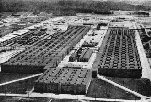It is against this background that Szilard fretted about the possibility of an atomic bomb. The discovery of fission came just as Germany was girding itself to abandon expansion by intimidation and resort to armed conquest.
World War II erupted at a moment when the promise of atomic energy had progressed from being possibile to being probable. It was not clear whether this energy could be released explosively however.
Szilard, as always, was both a man of vision and a man of action. Well known among European physicists, Szilard drafted a letter in consultation with Albert Einstein that was addressed from Einstein to President F.D. Roosevelt and which warned hime of the possibility of nuclear weapons (the "Einstein Letter"). This letter was delivered to FDR on October 11, 1939, and ten days later the first meeting of the Advisory Committee on Uranium (the "Briggs Uranium Committee") was held in Washington, DC on Pres. Roosevelt's order.
 Szilard and Einstein Together After the War
Szilard and Einstein Together After the War
Due largely to persistent official lack of interest, the progress on the subject was desultory and inconclusive in the United States. The next key developments occurred in the United Kingdom.
During February 1940, expatriot physicists Otto Frisch and Rudolf Peierls, living in the UK prepared a theoretical analysis of the possibility of fast fission in U-235. Their report contains the first well grounded (although rough) estimates of the size of a critical mass ("a pound or two") and probable efficiency, and proposed practical schemes for bomb design and the production of U-235. This "roadmap" for fission weapon development would be elaborated upon and modified to a spectacular degree in the coming years, but it remains basically sound.
So persuasive is the report by Frisch and Rudolf Peierls' that a study committee is formed at the highest levels of goverment (eventually code-named the MAUD Committee) on April 10. By December the MAUD Committee would issue a key report selecting gaseous diffusion as the most promising method of uranium enrichment.
Through 1940 and well into 1941, work accelerated in the U.S., and important discoveries accumulated although official interest and support languished. In February, 1941 Philip Abelson began actual development of a practical uranium enrichment system (liquid thermal diffusion) and on February 26 Glenn Seaborg and Arthur Wahl discover plutonium. During March the first American measurements of the U-235 fission cross section allow Peierls to calculate the first experimentally supported estimate of a critical mass for U-235 (18 lb as a bare sphere, 9-10 lb when surrounded by a reflector).
By July 1941 plutonium was demonstrated to be a superior fissile material, and the MAUD Committee completed its final report, describing atomic bombs and project propsals for building them in some technical detail.
On September 3, 1941, with PM Winston Churchill's endorsement, the British Chiefs of Staff agree to begin development of an atomic bomb. But it is not until December 18, after months of bureaucratic struggling and the U.S. entry into the war, that a U.S. project to investigate atomic weapons (as opposed to "study fission") finally gets underway.
This Manhattan Project predecessor, code named the S-1 project, was headed by Arthur H. Compton. The core group of scientists that would lead the development of the atomic bomb had coalesced well before this, and was already working as hard as resources allowed on the problem.
In January 1942, Enrico Fermi's on-going work with graphite and uranium was transferred to a new secret project, code named the Metallurgical Laboratory (Met Lab) at the University of Chicago. In April Fermi begins design of CP-1, the world's first (human built) nuclear reactor.
Throughout early and mid 1942, fundamental neutron physics research proceeded, as did work on developing industrial scale processes for producing fissile materials. But it became increasingly obvious that since this was to be an industrial scale project, a proven project manager was called for. Furthermore, since it was a weapons project, it need to be brought under an organization experienced in producing weapons.
On June 18, 1942 Brig. Gen. Steyr ordered Col. James Marshall to organize an Army Corps of Engineers District to take over and consolidate atomic bomb development. During August Marshall created a new District organization with the intentionally misleading name "Manhattan Engineer District" (MED), now commonly called "The Manhattan Project".
The Manhattan Project
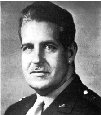
Despite its official founding in August, the Manhattan Project really began on September 17, 1942 when Col. Leslie Richard Groves was notified at 10:30 a.m. by Gen. Brehon Somervell that his assignment overseas had been cancelled. Groves, an experienced manager who had just overseen the collosal construction of the Pentagon, seized immediate and decisive control. In just two days he resolved issues that had dragged on for months under Compton. On September 18 Groves ordered the purchase of 1250 tons of high quality Belgian Congo uranium ore stored on Staten Island, and the next day purchased 52000 acres of land to be the future site of Oak Ridge. Groves was promoted to Brigadier General on September 23. By September 26 Groves had secured access to the highest emergency procurement priority then in existence (AAA).
The era of weak, indecisive leadership was over.
Groves' pushy, even overbearing, demeanor won him few friends among the scientists on the Manhattan Project (in particular a special enmity developed between Groves and Szilard). Many detested him at the time, considering him a boor and a buffoon. It was only after the war that many scientists began to appreciate how crucial his organizational and managerial genius was to the MED.
During the fall, while Fermi built CP-1 in Chicago, Groves took the fissile material programs out of the hands of the scientists and placed them under the management of industrial corporations like DuPont and the Kellog Corporation. He ordered construction begun immediately on the fissile material production plants, even though designs and plans had not yet been drawn up, realizing that the same basic site preparation work would be required no matter what.
On October 15, 1942 Groves asks Dr. J. Robert Oppenheimer to head Project Y, the new planned central laboratory for weapon physics research and design. The site for which he selected on November 16 at Los Alamos, New Mexico.
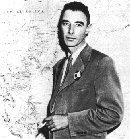 Dr. J. Robert Oppenheimer (taken during 1945)
Dr. J. Robert Oppenheimer (taken during 1945)
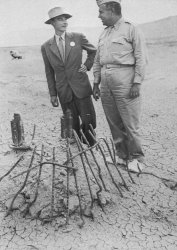 340x480, 40 K |
Oppenheimer and Groves inspecting the remains of the Trinity test tower, 9 September 1945. Despite his suit, in this picture you can sense how emaciated Oppenheimer had become during the Manhattan Project. |
| Click for big image (532x750, 86 K) |
Oppenheimer, a professor of physics at Berkeley, had demonstrated a special skill at leading groups of scientists during the S-1 program, which Groves quickly took notice of. Oppenheimer and Groves developed a good relationship, each recognizing how critical the other was to the project.
On December 1, 1942, after 17 days of round-the-clock work Fermi's group completed CP-1 (sooner than planned) when Fermi projected that a critical configuration had been reached. It contained 36.6 metric tons of uranium oxide, 5.6 metric tons of uranium metal, and 350 metric tons of graphite.
On December 2, 1942 - 3:49 p.m. CP-1 went critical and was allowed to reach a thermal output of 0.5 watts (ultimately it was operated up to a maximum power level of 200 watts).
In January, 1943 Groves acquired the Hanford Engineer Works, 780 square miles of land on the Columbia River in Washington for plutonium production reactors and separation plants. During March Los Alamos began operations as the staff arrived.
During the remainder of 1943, work continued on the construction of the plutonium production facilities (reactors and chemical processing) at Hanford, and the uranium enrichment plants (gaseous diffusion and electromagnetic separation) at Oak Ridge. A large experimental graphite reactor (the X-10) was also constructed at Oak Ridge to provide research quantities of plutonium, and went critical on November 4. Refinement of gun-assembly based weapon designs continued at Los Alamos. Preliminary implosion research also proceeded, initially at a low level of effort, but after promising early results at an accelerated rate late in the year.
The first attempt at large scale uranium enrichment, the electromagnetic Alpha tracks at Oak Ridge, went on-line in the fall, but failed completely. By the end of the year complete rebuilding was ordered.
Also in the fall, Project Alberta began. Its purpose was to prepare for the actual combat delivery of atomic weapons by conducting weapons delivery tests, modifying aircraft for carrying the atomic weapons, and organizing and training flight crews and field teams for weapons handling.
In 1944 work proceeded on all fronts:
- weapon development
- fissile material production
- combat delivery preparations
In January a major problem surfaced with the diffusion barriers intended for the K-25 gaseous diffusion plant at Oak Ridge. The process then being developed for barrier production seemed unpromising, and Groves to switched planned production to a new process creating months of delays in equipping K-25 for operation. Abelson, then in the process of constructing a thermal diffusion uranium enrichment plant, learned about the problems with the Manhattan Project's gaseous diffusion plant, and leaked information about his technology to Oppenheimer.
On April 5 the first sample of X-10 reactor produced plutonium arrived from Oak Ridge. Emilio Segre immediately began monitoring its spontaneous fission rate. By April 15 his preliminary estimate of a spontaneous fission rate indicated that it was far too high for gun assembly. The report was kept quiet due to limited statistics, and observations continued.
By mid-May 1944, six months after the start of accelerated implosion research, little progress towards successful implosion had been made. The experimental and theoretical work on the problem had been reorganized a number of times, and resources devoted to it kept expanding. New IBM calculating equipment was now being put to use. At this point two British scientists joined Los Alamos who had important impacts on the implosion program. Geoffrey Taylor (arrived May 24) pointed out implosion instability problems (especially the Rayleigh-Taylor instability), which ultimately led to a very conservative design to minimize possible instability problems. James Tuck brought the critical idea of explosive lenses for detonation wave shaping.
On June 3, after visiting the thermal diffusion uranium enrichment pilot plan at the Naval Research Laboratory, a team of Manhattan Project experts recommended that a plant be built to feed enriched material to the electromagnetic enrichment plant at Oak Ridge. On June 18 Groves contracted to have S-50, a liquid thermal diffusion uranium enrichment plant, built at Oak Ridge in no more than three months.
On July 4, 1944 Oppenheimer revealed Segre's spontaneous fission measurements to the Los Alamos staff. The neutron emission for reactor-produced plutonium was too high for gun assembly to work. The measured rate was 50 fissions/kg-sec, the fission rate in Hanford plutonium is expected to be over 100 times higher still.
This discovery was a turning point for Los Alamos, the Manhattan Project, and eventually for the practice of large scale science after the war. The planned plutonium gun had to be abandoned, and Oppenheimer was forced to make implosion research a top priority, using all available resources to attack it. A complete reorganization of Los Alamos Laboratory was required. With just 12 months to go before expected weapon delivery a new fundamental technology, explosive wave shaping, had to be invented, made reliable, and a enormous array of engineering problems had to be solved. During this crisis many foundations for post-war science were laid. Scientist- administrators (as opposed to academic or research scientists) came to the forefront for running large scale research efforts. Automated numerical techniques (as opposed to manual analytical ones) were applied to solve important scientific problems, not just engineering applications. The dispersal of key individuals after the end of the war later carried these insights, as well as the earlier organizational principles developed at Los Alamos throughout American academia and industry.
July 1, 1944 - The Manhattan Project was granted the highest project-wide procurement priority (AA-1).
July 20, 1944 - The Los Alamos Administrative Board decided on a reorganization plan to direct the laboratory's full resources on implosion. Instead of being organized around scientific and engineering areas of expertise, all work was organized around whether it applied to implosion, or the uranium gun weapon, with the former receiving most of the resources. The reorganization was completed in less than two weeks.
During August Groves made his first estimate of bomb availability since the beginning of the Manhattan Project (the estimate was mid-spring 1945). Also this month the Air Force began modifying 17 B-29s for combat delivery of atomic weapons.
 Alpha Tracks at Y-12
Alpha Tracks at Y-12
 The Alpha Track Control Room
The Alpha Track Control Room Beta Tracks at Y-12
Beta Tracks at Y-12
September 1944 marked a difficult period:
- K-25 was half built, but no usable diffusion barriers had been produced. The Y-12 electromagnetic enrichment plant was operating at only 0.05% efficiency. S-50 enrichment plant began partial operation at Oak Ridge, but leaks prevented substantial output. The total production of highly enriched uranium to date was only a few grams. The only workable bomb design at hand, the gun-type weapon, required U-235 which has no proven practical production methods available.
- Plutonium production had not yet begun, but the production techniques appeared to have a high probability of success. However plausible approaches to building a plutonium bomb did not yet exist.
- Project Alberta on the other hand has moved into a new phase as Air Force Lt. Col. Paul Tibbets began organizing the 509th Composite Group, which would deliver the atomic bombs in combat, at Wendover Field, Utah. [Interestingly, the 509th stayed together after the war and exists to this day (1999) as a US Air Force Strategic Command bomber force.]
Then, a new crisis struck the plutonium production effort. On September 26 the first full scale plutonium reactor, the B pile, at Hanford was completed and loaded with uranium. This reactor contained 200 tons of uranium metal, 1200 tons of graphite, and was cooled by 5 cubic meters of water/sec. It was designed to operate at 250 megawatts, producing some 6 kg of plutonium a month. On this day Fermi supervised reactor's first start-up. After several hours of operation at 100 megawatts, the B pile inexplicably shut down, then started up again by itself the next day. Within a few days this was determined to be due to poisoning by the highly efficient neutron absorber Xenon-135, a radioactive fission product. The B reactor, and others under construction, had to be modified to add extra reactivity to overcome this effect before production could begin.
October 27, 1944 - Oppenheimer approved plans for a bomb test in the Jornada del Muerto valley at the Alamagordo Bombing Range. Groves approved the plan 5 days later, provided that the test be conducted in Jumbo.
By the end of the year things start looking up;
- Y-12 output had reached 40 grams of highly enriched uranium a day in November, then to 90 grams/day in December.
- In Mid-December the first successful explosive lens tests established the feasibility of making an implosion bomb.
- December 17, 1944 - The D pile went critical with sufficient reactivity to overcome fission product poisoning effects. Large scale plutonium production begins.
 The Y-12 Plant
The Y-12 Plant
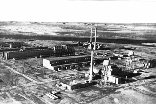 The D-Reactor at Hanford
The D-Reactor at Hanford
By the start of 1945 the Manhattan Project had 'turned the corner'. The uranium bombs seemed assured of success in a matter of months. The prospects for the plutonium bomb were looking up although meeting an August 1 deadline imposed by Groves was far from certain. However, allied military successes against Germany and Japan made it a horse race to see whether it would matter to the war effort.
January, 1945:
- Y-12 output reached an average of 204 grams of 80% U-235 a day; projected production of sufficient material for a bomb (~40 kg) was July 1.
- Usable barrier tubes began arriving at the K-25 plant. The first stage of the K-25 plant was charged with uranium hexafluoride and began operation.
- The Dragon experiment (January 18), conducted by Frisch, created the world's first assembly critical through prompt neutrons alone (i.e. it reached prompt critical). The largest energy production for a drop was 20 megawatts for 3 milliseconds (the temperature rose 6 degrees C in that time).
February, 1945:
- The F reactor went on-line at Hanford, raising theoretical production capacity to 21 kg/month.
- Uranium gun design was completed and frozen. Only planning for deployment and combat use once the U-235 was deliveredwas now required.
- Plutonium began arriving from Hanford.
- Tinian Island was selected as the base of operations for atomic attack.
- A meeting between Oppenheimer, Groves, and Los Alamos division leaders (February 28) fixed the design approach for the plutonium bomb. The next day the powerful Cowpuncher Committee was organized to "ride herd" on implosion bomb development.
March, 1945:
- S-50 thermal diffusion plant finally began enriching uranium in quantity.
- Oppenheimer officially froze explosive lens design (March 5).
- By mid month the first evidence of solid compression from implosion was observed (5%).
April, 1945:
- April 3 - Preparations began at Tinian Island to support the 509th Composite Group, and to assemble the atomic bombs.
- April 11 - Oppenheimer reported optimal performance with implosion compression in sub-scale tests.
- April 12 - President Roosevelt died of a brain hemorrhage.
- April 13 - Pres. Truman learned for the first time of the existence of atomic bomb development from Secretary of War Henry Stimson.
- April 25 - Truman received first in-depth briefing on the Manhattan Project from Stimson and Groves.
- April 27 - The first meeting of the Target Committee was held to select targets for atomic bombing. Seventeen targets are selected for study: Tokyo Bay (for a non-lethal demonstration), Yokohama, Nagoya, Osaka, Kobe, Hiroshima, Kokura, Fukuoka, Nagasaki, and Sasebo (some of these were soon dropped because they had already been burned down).
| The 100 Ton Test | ||
|---|---|---|
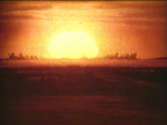
|
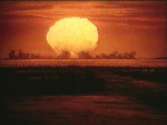
|
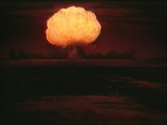
|
May, 1945:
- May 7 - The 100-ton test was conducted. 108 tons of Composition B, laced with 1000 curies of reactor fission products, were exploded 800 yards from Trinity ground zero to test instrumentation for Trinity. This was the largest instrumented explosion conducted up to this date.
- May 8 - V-E Day. Germany formally capitulated to the allies.
- May 9 - The draft of general procedures for atomic bombing were completed.
- May 10 - Target Committee reconvened. The target list was shortened to Kyoto, Hiroshima, Yokohama, and Kokura Arsenal.
- Mid-May - Little Boy was ready for combat use, except for the U-235 core. It was estimated that sufficient material would be available by 1 August.
- May 25 - Operation OLYMPIC, the invasion of Kyushu (the southern Japanese island), was set for November 1.
- May 28 - Target Committee met with Lt. Col. Tibbets in attendance. Tibbets estimated that by Jan. 1, 1946 all major cities of Japan will have been destroyed by fire bombing. The target list was now Kyoto, Hiroshima, and Niigata.
- May 30 - Sec. of War Stimson ruled out Kyoto, the ancient capital of Japan, as a target for atomic attack.
June, 1945:
- June 10 - 509th Composite Group crews began arriving on Tinian with their modified B-29s.
- June 24 - Frisch confirmed that the implosion core design is satisfactory after criticality tests.
- Late June - LeMay estimated that the Twentieth Air Force would finish destroying the 60 most important cities in Japan by Oct. 1.
July, 1945: Final preparations began at the New Mexico test site, the Jornada del Muerto at the Alamagordo Bombing Range, for the first atomic bomb test, code named Trinity. The date was set for July 16.
- July 3 - Casting of the U-235 projectile for Little Boy was completed.
- July 7 - Explosives lens casting for Trinity was completed.
- July 10 - The best available lens castings were selected for Trinity.
- July 11 - Assembly of Gadget, the first atomic bomb began.
- July 12-13 - The plutonium core and the Gadget components left Los Alamos for the test site separately. Assembly of Gadget began at 1300 hours on July 13. Assembly of Gadget's explosive lens, uranium reflector, and plutonium core was completed at Ground Zero at 1745 hours.
- July 14
- Gadget was hoisted to the top of the 100 foot test tower, and the detonators were installed and connected. Final test preparations began.
- Little Boy bomb units, accompanied by the U-235 projectile, were shipped out of San Francisco on the USS Indianapolis for Tinian.
- The only full scale test of the implosion lens system (before Gadget) was conducted. Initial analysis indicated failure, but Bethe later corrected mistaken calculations and found that the measurements were consistent with optimum performance (he also discovered that the test instrumentation was incapable of distinguishing success from failure).
- July 16 - At 5:29:45 a.m. Gadget was detonated in the first atomic explosion in history. The explosive yield was 20-22 Kt (initially estimated at 18.9 Kt), vaporizing the steel tower.






